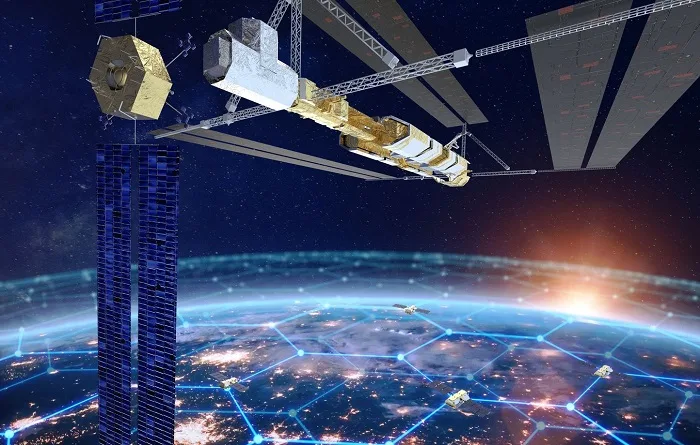
Data Centers in Space: The Next Frontier in Technology
In recent years, the concept of placing data centers in space has evolved from science fiction to a viable technological endeavor. The technology involved in this ambitious project includes advanced satellite systems, space-grade hardware, and innovative cooling solutions. High-throughput satellites (HTS) equipped with state-of-the-art processors are essential for managing and processing vast amounts of data in orbit. These satellites use cutting-edge materials and design principles to ensure they can withstand the harsh conditions of space, such as extreme temperatures and radiation.
Another critical aspect is the development of space-grade hardware capable of operating efficiently in zero gravity. This includes specialized servers, storage devices, and networking equipment designed to function reliably without the cooling mechanisms typically used on Earth. Innovative cooling solutions, such as passive cooling and heat dissipation technologies, are also crucial. These systems leverage the vacuum of space to manage heat, reducing the need for traditional cooling methods like air conditioning, which are impractical in the space environment.
How It Works and Why It’s Important
The operation of space-based data centers involves several key processes. Data is transmitted from Earth to satellites using secure, high-speed communication links. These satellites then process and store the data, utilizing their onboard computing resources. The processed data can be sent back to Earth or relayed to other satellites for further distribution. This process is facilitated by advanced communication protocols and encryption techniques to ensure data integrity and security.
Placing data centers in space offers several significant advantages. It helps alleviate the growing demand for data processing and storage on Earth, reducing the strain on terrestrial data centers. Additionally, space-based data centers can provide global coverage, ensuring that data services are available in remote and underserved regions. This capability is particularly important for applications requiring real-time data processing and low-latency communication, such as autonomous vehicles, remote sensing, and global internet connectivity.
What is the Point of Moving Data Centers into Space?
The primary motivation for relocating data centers to space is to address the limitations and challenges faced by terrestrial data centers. Earth-based data centers require significant amounts of land, power, and cooling resources, which are becoming increasingly scarce and expensive. By contrast, space offers an almost limitless environment with abundant solar energy, making it an ideal location for sustainable data center operations.
Another compelling reason is the potential for improved data security and disaster resilience. Space-based data centers are less vulnerable to natural disasters, cyber-attacks, and physical breaches that can compromise terrestrial facilities. This makes them an attractive option for storing sensitive data and maintaining business continuity in the event of terrestrial disruptions.
Furthermore, the deployment of data centers in space supports the broader trend of space commercialization and exploration. As more companies and governments invest in space infrastructure, the cost of launching and maintaining satellites is expected to decrease, making space-based data centers more economically viable. This aligns with the vision of creating a sustainable space economy that benefits various industries on Earth.
What Are the Advantages of This Idea?
The advantages of space-based data centers are numerous. First and foremost, they offer a sustainable solution to the increasing demand for data processing and storage. By utilizing solar energy and eliminating the need for traditional cooling systems, these data centers can operate more efficiently and with a smaller environmental footprint.
Secondly, space-based data centers can provide unparalleled global coverage. This is particularly beneficial for remote and underserved regions that lack reliable internet and data services. By positioning data centers in geostationary orbits, it is possible to deliver consistent and high-speed connectivity to every corner of the globe.
Additionally, the enhanced security and resilience of space-based data centers make them an ideal choice for critical applications. Data stored and processed in space is less susceptible to physical and cyber threats, ensuring greater data integrity and availability. This is particularly important for industries such as finance, healthcare, and government, where data security is paramount.
Finally, the development of space-based data centers drives innovation and technological advancement.The challenges of operating in space necessitate the creation of new technologies and solutions that can also benefit terrestrial applications. This can lead to breakthroughs in areas such as energy efficiency, cooling systems, and materials science.

What Are the Disadvantages of This Idea?
Despite the numerous advantages, there are also significant challenges and disadvantages associated with space-based data centers. One of the primary concerns is the high cost of launching and maintaining satellites. While the cost of space missions has decreased in recent years, it remains a substantial investment compared to building and operating terrestrial data centers.
Another challenge is the technical complexity and risk involved in operating in the harsh environment of space. Satellites and space-grade hardware must be designed to withstand extreme temperatures, radiation, and microgravity, which can affect their performance and longevity. Additionally, the repair and maintenance of space-based equipment are significantly more difficult and costly than for Earth-based systems.
There are also regulatory and legal challenges to consider. The deployment of data centers in space requires coordination with international space agencies and compliance with various space treaties and regulations. Ensuring that data transmitted and stored in space adheres to privacy and security laws is another complex issue that needs to be addressed.
Conclusion on Prospects
The concept of space-based data centers represents a bold and innovative approach to addressing the growing demands of the digital age. While there are significant challenges and costs associated with this endeavor, the potential benefits in terms of sustainability, global coverage, and data security are substantial. As technology continues to advance and the cost of space missions decreases, the feasibility of deploying data centers in space will improve.
In the long term, space-based data centers could become a critical component of the global data infrastructure. They offer a promising solution to the limitations of terrestrial data centers and support the broader goal of sustainable space commercialization. By investing in this technology, we can ensure that the digital infrastructure keeps pace with the rapid growth of data and connectivity demands.
Ultimately, the success of space-based data centers will depend on continued innovation, collaboration, and investment. As we look to the future, it is clear that space holds the key to unlocking new possibilities for data processing, storage, and distribution, benefiting industries and individuals worldwide.
Popular articles
-
 Digital twins in 2025–2026: real city, fac...
Digital twins in 2025–2026: real city, fac...Digital twins have moved well beyond the “nice-to-have” stage. In 2025 and …
Learn more -
 Why Modern Technologies Are Becoming More ...
Why Modern Technologies Are Becoming More ...Modern technologies are developing at a pace that few users can fully …
Learn more -
 Next-Generation Home Batteries: Hybrid Ene...
Next-Generation Home Batteries: Hybrid Ene...Hybrid home batteries have become a practical foundation for residential energy autonomy …
Learn more
